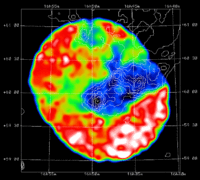Radiation astronomy/X-rays/Course
< Radiation astronomy < X-rays
| |
Completion status: this resource is just getting off the ground. Please feel welcome to help! |
The course objective is to provide students with a dynamic course focused on X-ray astronomy. At the end of the course, a student should have a well-rounded knowledge of the observational and theoretical astronomy of X-ray astronomy.
| |
Educational level: this is a secondary education resource. |
The course is built upon the ongoing research performed by astronomers around the world and in the not so empty space above the Earth's atmosphere.
| |
Educational level: this is a tertiary (university) resource. |
The course material is layered from a secondary to a university or tertiary level, topped off with an introduction to research, some of which is here at Wikiversity.
| |
Educational level: this is a research resource. |
The general subject area is astronomy. But, this includes knowledge from physics, chemistry, geography, history, and other subjects.
| |
Resource type: this resource is a course. |
| |
Subject classification: this is an astronomy resource. |
Prerequisites
Although a working knowledge of calculus and physics are beneficial, most of the concepts presented only require algebra. Additional learning resources where the student may increase their background knowledge while progressing through the course are provided.
Completion levels
This course is dynamic, but may also be taken as a semester offering by Wikiversity, see the syllabus near the bottom of this page for the next formal class period.
Each component resource has a level of completion icon following it based on ≥ 100 kb equals 100 %, or 100 questions is 100 %, the midterm and final are based on 300 questions equals 100 %:
- This resource is a stub, which means that pretty well nothing has been done yet. 0-5%.

- This resource is just getting off the ground. Please feel welcome to help! 6-15%.

- Been started, but most of the work is still to be done - 16-30%.

- About halfway there. You may help to clarify and expand it - 31-45%.

- Almost complete, but you can help make it more thorough - 46-60%.

- Ready for testing by learners and teachers. Please begin! 61-75%.

- This resource is considered to be ready for use - 76-90%.
 R
R - This resource has reached a high level of completion - 91-100%.
 C
C
Laboratories
Lectures
For a sixteen-week course, forty-eight lectures are needed. But, this is an advanced and specialized course so the number of lectures may vary.
- Astronomical X-ray entities
- Astronomical X-ray objects
- Astronomical X-ray sources
- Balloons for X-ray astronomy
- Coronal cloud
 C
C - Earth-orbit X-ray astronomy
- Electron astronomy
 C
C - Exploratory X-ray astronomy
- First astronomical X-ray source
 R
R - Galactic X-ray astronomy
- Gamma-ray astronomy
 C
C - Hard X-ray astronomy
- History of X-ray astronomy
- Magnetohydrodynamics
 R
R - Nucleosynthesis

- Scorpius X-1
- Sounding rockets for X-ray astronomy
- Stellar active region
 C
C - Stellar surface fusion
 C
C - Sun as an X-ray source
 C
C - Super soft X-ray astronomy
- Theoretical X-ray astronomy
- Ultraviolet astronomy
 C
C - Vela X-1
- X-ray astronomy
 C
C - X-ray astronomy detectors
- X-ray astronomy satellites
- X-ray astronomy telescopes
- X-ray classification of stars
 C
C - X-ray trigonometric parallax
 C
C
Lessons
- First gamma-ray source in Triangulum Australe

- First X-ray source in Andromeda

- First X-ray source in Antlia

- First X-ray source in Apus

- First X-ray source in Aquarius

- First X-ray source in Chamaeleon
- First X-ray source in Lepus
- First X-ray source in Serpens Caput
- Serpens X-1

Quizzes
Each lecture has an associated quiz which is listed here.
Two-three lengthier exams often referred to as 'hourlies' (may take an hour to work through at a timed pace), a mid-term exam which is all-encompassing for the first half, and a final exam over the entire course material may be offered. The examinations are designed to be taken iteratively as many times as the student desires to achieve a thorough working knowledge of the subject.
- Balloons for X-ray astronomy/Quiz
- Coronal cloud/Quiz
- First astronomical X-ray source/Quiz

- Galactic X-ray astronomy/Quiz
- Gamma-ray astronomy/Quiz
- Hard X-ray astronomy/Quiz
- Magnetohydrodynamics/Quiz

- Nucleosynthesis/Quiz

- Sounding rockets for X-ray astronomy/Quiz
- Star-forming region/Quiz

- Stellar active region/Quiz

- Stellar surface fusion/Quiz

- Sun as an X-ray source/Quiz

- Super soft X-ray astronomy/Quiz
- Ultraviolet astronomy/Quiz
- X-ray astronomy/Quiz

- X-ray astronomy detectors/Quiz
- X-ray astronomy satellites/Quiz
- X-ray astronomy telescopes/Quiz
- X-ray classification of stars/Quiz

- X-ray trigonometric parallax/Quiz

See also
External links
- African Journals Online
- Bing Advanced search
- Google Books
- Google scholar Advanced Scholar Search
- International Astronomical Union
- JSTOR
- Lycos search
- NASA/IPAC Extragalactic Database - NED
- NASA's National Space Science Data Center
- NCBI All Databases Search
- Office of Scientific & Technical Information
- Questia - The Online Library of Books and Journals
- SAGE journals online
- The SAO/NASA Astrophysics Data System
- Scirus for scientific information only advanced search
- SDSS Quick Look tool: SkyServer
- SIMBAD Astronomical Database
- Spacecraft Query at NASA.
- SpringerLink
- Taylor & Francis Online
- Universal coordinate converter
- Wiley Online Library Advanced Search
- Yahoo Advanced Web Search